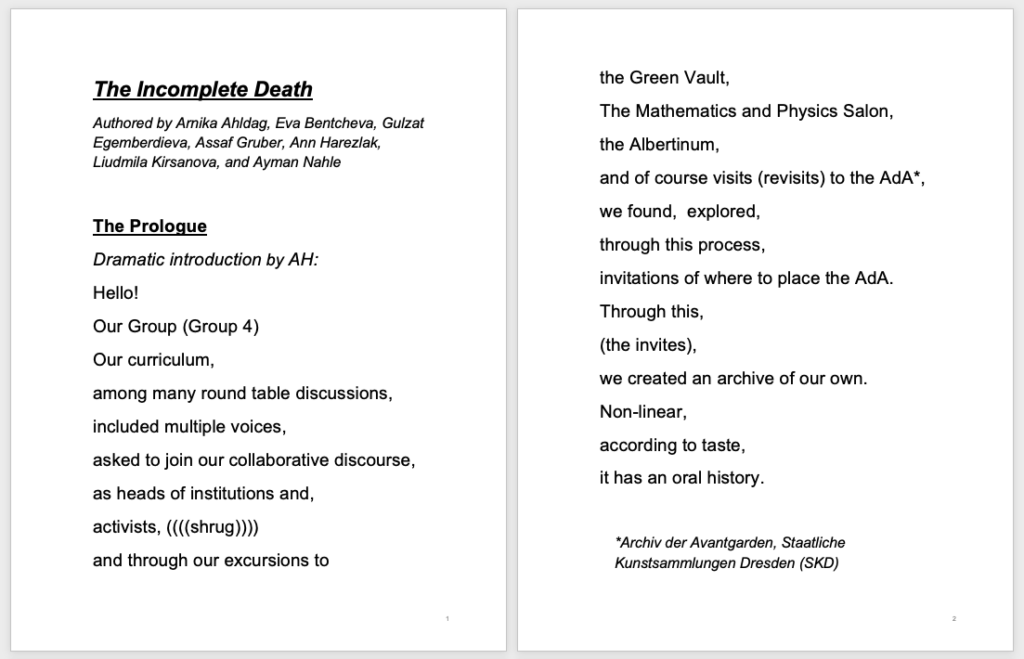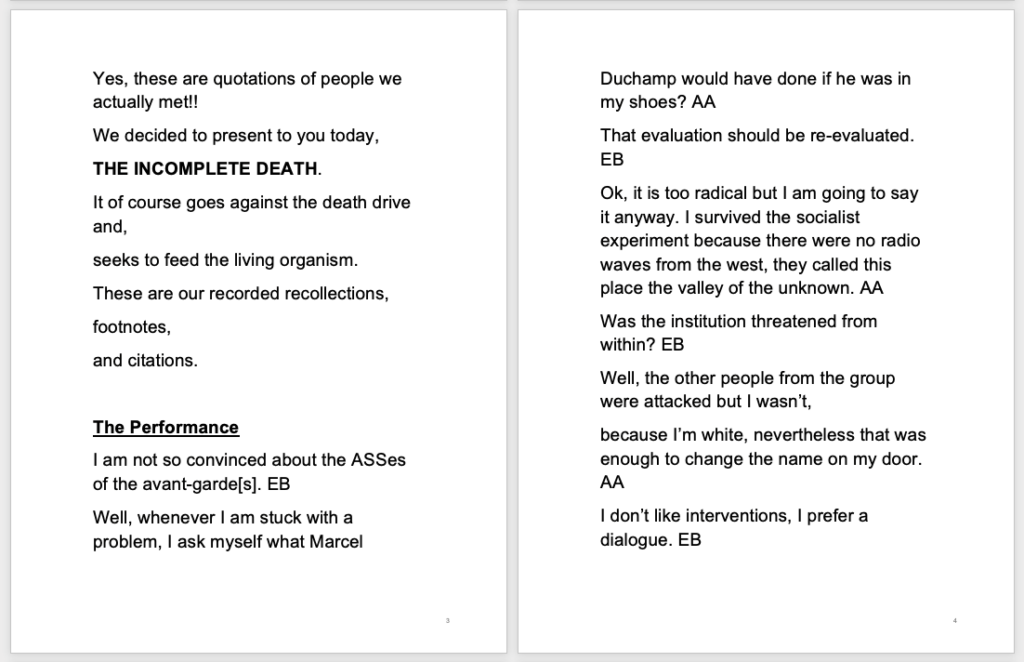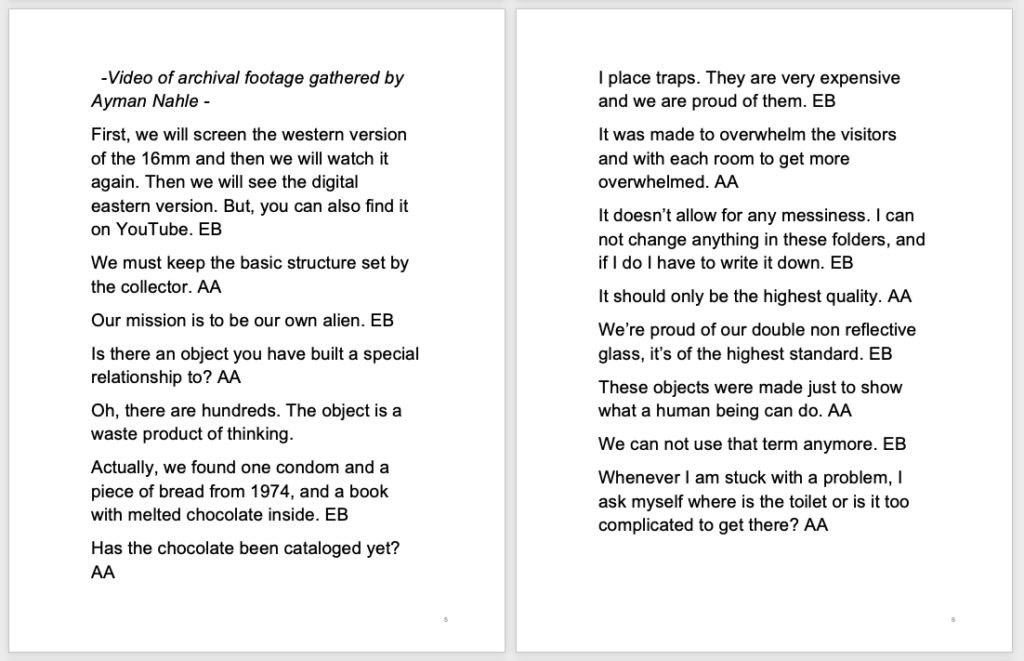Life Stories and Archives: A Time of Flux



A conversation about the entanglement of biographies and archives under the impressions of current social and political ruptures
During the Whole Life Academy 2019, as part of a small group we staged The Incomplete Death. A satirical piece that pulled from direct echoes of authority and expertise we encountered via invitation. It was staged as a performance which revisited multiple responses by archivists, curators, artists and museum directors to our examinations on collectors and collections. These individuals remained anonymous in our collage-like script. What emerged in place of their biographies was our fascination with how they responded to whether “the institution was threatened from within” or if an “evaluation should be re-evaluated.” We heard discussions on terms we could not use anymore and about how dialogue was preferred over intervention. What was considered of the highest standard and the highest quality, without any messiness, seemed to be championed. These reflections initially held us together as transient witnesses, studying the role of peripheral figures in narrative and myth building. Yet global economic and social disruption, more than just messiness, shifted the approaches and considerations for our international group; so now, we too play peripheral roles in the archives that we translate.
We gather together again to consider the intersections between biographies and archives. We seek to learn how biographies are mirrored in archives and identify types/tropes of ‘archive builders.’ As the last year went by, we acknowledged that when unraveling the ways in which biographies influence the coding of collections, our collective work had now become entangled in this continual shift of wider social and political dynamics. Our lives, the lives of the archives we consider, and our individual desires had experienced transformative ruptures to our approaches and considerations. Here we each reflect on the unstable present conditions and how this has shaped our thinking around where ‘life stories’ begin and archives end.
Ann Harezlak:
In response to our ongoing collaboration around ‘the archive’ and the intermixing of our ‘whole lives’, I had considered a possible restaging or performative reactivation of my personal ephemera archive. This truthfully would be the second time I explored this categorized material with others, which includes boxes of exhibition ephemera collected over fifteen years from projects I attended, supported, or activated. The first staging of my archive was at 3307 W. Washington Blvd in Los Angeles and it evoked questions about the development of networks, and the moral and ethical aspects of collaboration within the process of archiving. As part of An Archive-in-Residence, I transformed an artist-run space into a mock institution where the public was invited to browse, interpret, reorganize and inscribe new classifications and topologies to my archive. I acted as Head Archivist, gatekeeper of knowledge about the origin as well as original order of materials. The questions I posed to visitors were relational and suggested collective community engagement but ultimately were rooted in unpacking my individual biography and I worried what it would reveal of unconscious personal biases. I was the main storyteller and narrative, or so I thought, in my collection.
When planning for a restaging of my archive, I continued to wonder how individual mythologies of collections, especially private collections, can register as historic. I persisted in thinking about a socially reflexive culture of archiving and how it may destabilize traditional methods for assigning value to collected objects. Although these queries still align with my methodology for investigation, I have reset my focus to interpreting the individual biography’s role in wider arguments on the architecture of cultural development. I contemplate how my ephemera archive can be a working space to closely examine the socio-political context in which these materials were gathered, and how the choices I made in building this collection were governed by cultural systems. What modes of art production, institutional governing, and social discourse perpetuated these systems? What other approaches to language or theoretical models could have been included but also disseminated for translating and illustrating art culture? How can I approach ‘the archive’ and its material holdings with cultural humility?
The creative process of archive development is an artistic act, and exposure to alternative art theories, histories, and biographies within artistic communities, especially those that are not given a voice, is essential to understanding the complete organism of ‘the archive’. The composition of my collection and the specific contexts under which it was collected are complex factors in its value to others, as it is not a reflection of ‘a whole life’ nor should it be.
Eva Bentcheva:
Ann, I would like to pick up on your point about how individual mythologies register as historic. I find this a fascinating question; where and when does the process of collecting ‘end’ within the life – and afterlife – of an individual? How is the identity of the collector written into the collection? Does their relationship become more closely intertwined or distanced over time, depending on who is asking? Ann, you have first-hand experience with the intimacies of collecting. I on the other hand – a scholar, sometimes curator of contemporary art – have always observed this process at a distance. I have relied on making personal connections with collectors or archivists, making myself available and open to frank exchanges in order to gain behind-the-scenes glimpses or insights. In our workshop for The Whole Life Academy, I knew from the outset that I wanted to work with the archive and person, Veronika Radulovic. She is an artist born in North Rhine-Westphalia in Germany, whose personal journey to post-socialist Vietnam in the 1990s led her to create an expansive friendship and professional network there. She remained resident there for more than a decade, becoming part of the art scene in Hanoi and, in the process, gathering archival documents, artworks and her own documentation of the period. This is now the largest personal archive of Vietnamese contemporary art in Berlin. Yet, she still describes this archive as part of her own being an incidental figure, or ‘transient witness’, to Vietnam of the time.
I met Veronika in Berlin in 2017 and was struck by how she recalled her time in Vietnam and her collection’s afterlife as one in constant flux, continually reliant on rhizomatic friendship networks within Vietnam and the diaspora. Her’s was both a personal archive and, at the same time, one married to the biographies of countless others. Our encounter flourished into a series of real-life meetings in which Veronika’s ‘life story’ became entangled with mine. We would meet and talk amidst the archive, not always looking into it, but often just being in its presence. As the pandemic came about in 2020 and these real life exchanges became more sporadic, I watched from a virtual distance as Veronika used the time to reorganise her archive. Where it had once stood on the ground level surrounded by large windows, she shifted it to the back inner half of her studio. Out of sight, it could be visited more upon appointment rather than ‘witnessed’ alongside incidental coffees and chats. What had once been a haphazard act of glimpsing seemed to now be taking on a whole new level of consolidation and professionalization as a research resource. How would this change the emplacement of Veronika’s life story within the archive, I would ask myself. She as a person was still very much present; to enter the studio in the first place it required permission or invitation. Yet, in tandem with the physical shift of boxes filled with correspondence, photo albums, video and tape cassettes, framed posters and artworks, Veronika seemed to be taking steps towards granting the archive a space to become an entity of its own. The ‘Veronika Radulovic Archive’, as I have often referred to it, was stepping beyond the remit of Veronika’s biography. This conceptual ‘detachment’ (perhaps too strong a word, I realize) came to fruition in 2021. Veronika finalized co-editing a book together with Annette Bhagwati titled Don’t Call It Art. Here her personal life story – a core feature of her earlier publications – now took on a background role to present the biographies of four artists who feature prominently in her archive. Publishing for the first time hundreds of images from her collection, this book will serve as a productive archival offshoot in which a personal ‘mythology’ morphed into a historical ‘node’. It was well and truly the product of a moment of instability in the present – social, political, personal and artistic. For me, it seemed to fuel the need to think about the timing and dynamics underway when the ‘life story’ of the individual collector intersects not only with the predicaments of other individuals, but also with some major institutional and national changes.
Arnika Ahldag:
Eva and Ann, I am picking up from both your questions of how the collector is written into the archive or collections, and when does it all end? My session for our workshop looks at a moment in time in the past, namely, at the founding moment of the National Gallery of Modern Art in New Delhi under the guidance of Hermann Goetz and on request of the first Prime Minister of India, Jawaharlal Nehru. At that point in time, just after the country had experienced independence from British rule, there was a push towards building institutions to stabilize the young nation state. Many of these institutions are now crumbling, under the nationalist drive of the current Indian government. Therefore we can’t think about the archive/collection-building moment that went hand in hand with a nation-building process back then, without considering the destruction of those very same archives and institutions today.
Like in many other parts of the world, at the moment of decolonization, it was in the newly formed government’s interest to set up institutions to demonstrate sovereignty and to build a narrative about a glorious and rich past, to exhibit historical depth at a moment of desire for the future. Today, the present government is reimagining AND rebuilding the entire stretch that hosts these collections and archives, physically and namely the National Museum, the Indira Gandhi National Centre for the Arts and the annex of the National Archives as part of the Central Vista. The exact plans are still unknown at this moment in time but we fear it destroys so much more than the physical buildings and what they represent. Apparently there will be a “Museum of Democracy” in the old Parliament House and once more, 71 years later, a nation, or much more it’s government reinvents its own narrative of past and present.
The National Gallery of Modern Art too was established a few years after independence, yet showing contemporary art and not past glory, yet it was built by desire too. If a museum’s obligation is to care for its objects, then it was Prime Minister Nehru’s care that was directly transferred to the institution, over a collection a love of his had left behind, to give them a home, a future and an audience.
Despite the National Gallery of Modern art having remained closed due to the pandemic in the last 1 1/2 years, the institution is not threatened (yet) by the agenda of the present government, but sadly, since it’s current director took over a few years ago the institution seems to have been sunk into a long slumber and we can only hope that the NGMA will be able to wake up from it one day and respond to our unstable present.
Gulzat Egemberdieva:
Ann, Eva and Arnika, since the workshop 2019 in Dresden and in light of our recent conversations, my thoughts on the archive have also been changing continuously. What was conceptualized as an archive by scholars, artists, collectors, and curators in Dresden was challenged when I confronted it with the place and time of my personal research activities.
After being guided through the precious collections of the Dresden museums, I started thinking about what should be kept, archived, musealized, from the regions inhabited by nomads – in the case of my research – the Pamir Kyrgyz, inhabitants of the Pamir mountains in Afghanistan. In 2017 some of them decided to travel back to their “home country” Kyrgyzstan, a journey of which they were dreaming for generations after being trapped “on the roof of the world” since the end of the 19th century. In their journey from Afghanistan, starting on horseback and ending in a transport by minibus, what archive could they bring back? Some kurut (pieces of dried yak cheese) in a kurzhun (two-sided transport bag for a horse), or eer (horse saddle), or some festive clothes? After Dresden I asked myself whether these objects could be considered as “a nomad archive” or even as an archive at all. Explorers such as Sven Hedin or Rick Rickmers certainly thought so. Hedin’s Pamir yurt, for example, is among the collections of the Berlin Ethnographic museum. My personal research shares and reflects the preoccupations of our group, attempting to learn how biographies are mirrored in archives and identify types/tropes of “archive builders,” and how the notion of “biography” is situated on the spectrum between the state, institutions, and individual drives. The new “home” of the Pamir Kyrgyz struggles itself with these questions. Existing as a “national” state since 1991, its Historical Museum is frozen between a nomad past, a no more existing Soviet past and a questionable postcolonial future. The new Historical Museum was supposed to open a few years ago, but it is still closed, caught in the dilemma of what to expose. Should objects of the Soviet past be part of it? Or the objects taken “back home” by the Pamir Kyrgyz? Should Hedin’s yurt be returned to the Bishkek Historical Museum? And if it does, how should it be presented?
Coda: With incomplete data for analyzing ‘the archive’ and its relationship to ‘everyday life’, especially in the context of biographies, our international and interdisciplinary group have not yet written our conclusions. Our fundamental explorations remain resolute, but our queries continue in flux as we gather material knowledge, examine overlooked narratives, and interpret collective humanity. Perhaps we will never compose a finale.
“That evaluation should be re-evaluated.”
— cited from The Incomplete Death, original declaration by an arts professional in Dresden in 2019.
This contribution was developed in the framework of the Whole Life Academy as part of the workshop “Life Stories and Archives”.
Connected Material
Paula Montesios und Eduardo Molinari speak about their artistic practices and how they are related to archives. Together they reflect about counter-archiving, para-archiving and un-archiving and how this includes experiences with and appearances of sensorial encounters with the past.
The legacy of anti-colonial leader and Pan-Africanist revolutionary Amílcar Cabral (1924-1973) still calls for cultural readings, and not strictly political ones. Contemporary art, so-called “artistic research” and critical theory will benefit from a cross-disciplinary approach which puts Cabral as relevant to art or which turns Cabral’s many contributions into tools.
The video explores the encounter (digital and analogue) between the body and the archive.
These images were taken in the frame of The Whole Life Academy. Laura Fiorio accompanied the project as a photographer from the beginning in 2019 and developed her own approach of documenting archival sites and methods.
CLEPTOCRAZIA is an art and science festival curated by Valeria D’Ambrosio at Villa Romana in Florence. The project aims to disseminate knowledge on the roots of the environmental crisis through a cycle of lectures, screenings and performances with the contribution of international artists and scientists.
The Perverted Archival Image workshop centered on and tentacled off from Studio Baalbeck. The workshop participants created an audio montage of recordings to accompany some of the visual archive material.
This collective chain uses multiple entry points to reflect on the encounter of archival practices, objects and material with non-linear timelines.
This workshop addressed archives as related to overlapping sites of nature/culture, climate change, deep time, and the built environment. The following texts and visual materials offer insight into individual participants’ research on
What does it mean to do archival research in embodied ways? Where is ‘the archive’ located in such an approach? And how might the open form of ‘the score’—a provisional map, a musical or performance score, a speculative cartography, an image atlas, a set of instructions—offer possibilities for articulating and transmitting the knowledge of elusive archives?
This Academy workshop addressed archives as related to overlapping sites of nature/culture, climate change, deep time, and the built environment. The texts and visual materials include an introduction to the workshop’s components and sites.